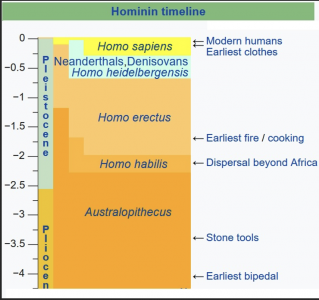By Vidya Rajan, Columnist, The Times
 In my Inner Nature article on the dye called Tyrian purple, I alluded to its stratospheric value in ancient times because it adhered to fabric and also darkened over time. Consequently, I thought to look at the origins of the fabrics that we wear and use, focusing on fabrics of natural origin. But before discussing specific fabrics, I need to touch on some other things that may have influenced people to wear clothing in the first place: climate, and brain development.
In my Inner Nature article on the dye called Tyrian purple, I alluded to its stratospheric value in ancient times because it adhered to fabric and also darkened over time. Consequently, I thought to look at the origins of the fabrics that we wear and use, focusing on fabrics of natural origin. But before discussing specific fabrics, I need to touch on some other things that may have influenced people to wear clothing in the first place: climate, and brain development.
The first influencer is climate. In warm climates, clothing is largely designed for protection from the sun, rather than from cold. The most recent ice age lasted from 110,000 to 12,500 years ago, when Homo sapiens had already evolved. Earlier Homo species who had by then dispersed out of Africa presumably used animal skins for warmth, but this would have been opportunistic clothing rather than purposeful clothing for the uses we see today: modesty, status, protection and…faith. During Lent, a medieval practice was to wear coarse sackcloth or hairshirts called cilices against the skin to demonstrate penitence and serve as a constant reminder to avoid sinning. The other influencer was brain development. Around 2.4 million years ago, a mutation occurred in the jaw muscles of the human lineage in a myosin heavy chain protein called MYH16. In primates MYH16 is found in the temporalis and masseter muscles that connect the lower jaw to the sagittal crest at the top of the skull. The mutation decreased the muscles’ size and left the jaws weaker. According to Figure 1, Homo erectus had already tamed fire about 1.75 mya but its deliberate use for cooking is thought to be more recent, about 300,000-400,000 years ago [1]. The ability to use fire allowed the weaker-jawed Homo species to soften their food by cooking it, and the weaker pull on the skull where the muscles attach allowed the brain case to expand [2]. People could warm themselves around the fire, which was a bonus. Thus, by a simplistic heuristic, increase in brain power led to cultural technologies that had adaptive outcomes for climactic conditions. Clothing was also adaptive for parasites body lice and pubic lice and opportunistic skin beetles, moth larvae, and some fungi, which are found in deposits which contain fabric. These parasites have had humans scratching their heads and less polite body parts for millennia. Traces of fungi that decompose clothing have also been found associated with tracing the evolution of body lice from head lice led to the inference that clothing dated back to 170,000 years ago [3].

Figure 1: Excerpt of figure from Wikipedia’s Timeline of Human Evolution (https://en.wikipedia.org/wiki/Timeline_of_human_evolution). Note that fire was first used for cooking around 1.75 mya and modern humans (Homo sapiens) evolved around 0.2 mya. The mutation in MYH16 preceded both these events around 2.4 mya and the brain growth that followed probably influenced the behavior of taming fire and the deliberate use of clothing.
Fabric protects our naked bodies from the elements, and it is inferred that hominids lost their hair between 3 and 1.2 mya (cited in [3]). The use of skins for the purpose of protection is obvious – animals use it – and humans who hunted animals as food would have scraped the adherent meat off the skin and dried and wrapped it around themselves, linking it together with sinew thread and bone buttons. That much seems obvious and there is evidence that clothing with skins dates back to over 170,000 years ago, even before the latest ice age began 110,000 years ago. Although fire would have been in use to cook food and stay warm, clothing would have helped to endure the cold. The problem with fabric from prehistoric times is that it is biodegradable. It is also hard to know if skins found in fossilized deposits came from clothing or from food.
Therefore, the discovery of flax fibers deliberately twisted together and dated to 36,000 years ago in Dzudzuana Cave in the Republic of Georgia near the Black Sea indicates a watershed moment [4]. Some of the fabric was colored indicating the technology was presumably well developed to produce fabric dyes – no straightforward task. The twisted fabric strands came from the flax plant, Linum sp., that grew wild. The flax plant also produces linseed oil which is used in woodworking, and flaxseed and linseed cake which are used as nutritional supplements. Linum sp. was domesticated more than 5000 years ago in several parts of the world including Europe, Egypt, India, and China and used to make high quality linen cloth. Today, Russia is the largest commercial source of flax which has fallen out of fashion due to the abundance of other fabric options. There is an informative video on producing linen thread from the dried flax plant: https://youtu.be/Pxz1U1bG2Sg.
The main ingredient of the fibers of plants is cellulose. Pure cellulose fibers are also found in the flowers of the cotton plant in which the seeds are embedded. The fibers from the cotton bolls are long and can be twisted into thread and woven without having to be further purified. Hemp (Cannabis sp.) also has long standing use in fiber production. Like cotton, it has long fibers which is essential for the process of spinning strong thread, but cotton is softer. Hemp’s coarse fiber is used for making rope but, since the plant also produces marijuana, its growth is regulated. An option to commercial cultivation is to use plants low in the psychoactive ingredient tetrahydrocannabinol (THC). Besides these popular fiber plants, fibers are also produced by over 100 plants [5]. Prominent among them are bamboo (115 genera), jute (Corchorus sp.), nettles (Urtica sp.), hop plant (Humulus lupulus), lime (Tilia sp), Spanish broom (Spartium sp.), banana (Musa sp.), kenaf (Hibiscus cannabinus L), sisal (Agave sisalana), ramie (Boehmeria sp.) raffia (Raphia sp.) and milkweed (Asclepius sp.). A semi-synthetic type of fiber called rayon is made by breaking down cellulose into a slurry by chemical treatment and then extruding the viscous solution into fiber. Rayons were first produced in 1883 as a cheaper alternative to silk. Viscose, lyocell, and modal, all varieties of rayon, are made by slightly varying the production process. They can also be blended with cotton and other fibers to impart a silky feel to the final fabric.
Fibers from animal hair are extrusions of a protein called keratin, and has been used since time immemorial. Animal fiber includes wool from sheep (merino, karakul), rabbits (angora), camelids (camels, llamas, alpacas, vicuna, guanaco), goats (angora (mohair) cashmere, pashmina), cattle (bison, highland cattle, muskoxen (qiviut), yak, and even raccoons, opossums, sables (zibeline), nutrias, muskrats, beavers, and dogs.
Of all animal fibers, the most luxurious is silk from larva of the silk moth, Bombyx mori. The larva weaves a single long extrusion of silk into a ball-like cocoon to pupate within. Unfortunately for silk-makers and the pupa, its emergence as an adult from the cocoon breaks the strands. In order to preserve the strand, silk thread is harvested by boiling the cocoons before the adults emerge, which kills the pupa inside. Then the cocoon is agitated in water, and the silk thread is drawn out in a single fiber, almost a mile long, and spooled. Making silk is incredibly time and labor intensive, and the end product is therefore costly. In response to the cruelty associated with producing silk, a variety of ahmisa (non-violent) silks: eri, tasar, and muga, where the cocoons are allowed to develop fully are available, although there is pushback to the claim that these silks are really produced by non-violent practices. See http://www.wormspit.com/peacesilk.htm.
Finally, to leather and suede, which are composed of the protein collagen. Suede is produced by splitting leather to take off the top grainy layer. Leather manufacturing is exceedingly time consuming, often taking 10 days to go from hide to leather. First the skins of animals are salted, soaked in alkali, scraped free of meat and hair, treated with acidic tanning material to make them resistant to decay and to soften, neutralized, wetted, dried, flexed, and oiled. Younger animals typically have thinner and more flexible skin used for fine articles and clothing, and the thicker skins of adults can either be split into thinner layers or used for heavy leather items like boots. Leaving the fur on produces extra warm fabric like sheepskin because the fur traps insulating air.
The next time you brush the dog, try twisting the fibers together into yarn. That might make for a fun project as well as a collateral benefit: a well-groomed dog.
References
[1] Scott AC., (2018) When Did Humans Discover Fire? Time. Available: https://time.com/5295907/discover-fire/
[2] Hopkin M., “Jaw-dropping theory of human evolution,” Nature, News 2004-03-25 2004, doi: doi:10.1038/news040322-9.
[3] Toups M, Kitchen A, Light JE, Reed DL, “Origin of Clothing Lice Indicates Early Clothing Use by Anatomically Modern Humans in Africa,” Molecular Biology and Evolution, vol. 28, no. 1, pp. 29-32, 2010, doi: 10.1093/molbev/msq234.
[4] Lavole A. “Oldest-known fibers to be used by humans discovered,” in The Harvard Gazette, ed, 2009.
https://news.harvard.edu/gazette/story/2009/09/oldest-known-fibers-discovered/
[5] “Fiber Plants.” https://pfaf.org/user/cmspage.aspx?pageid=48, Columnist, The Times






